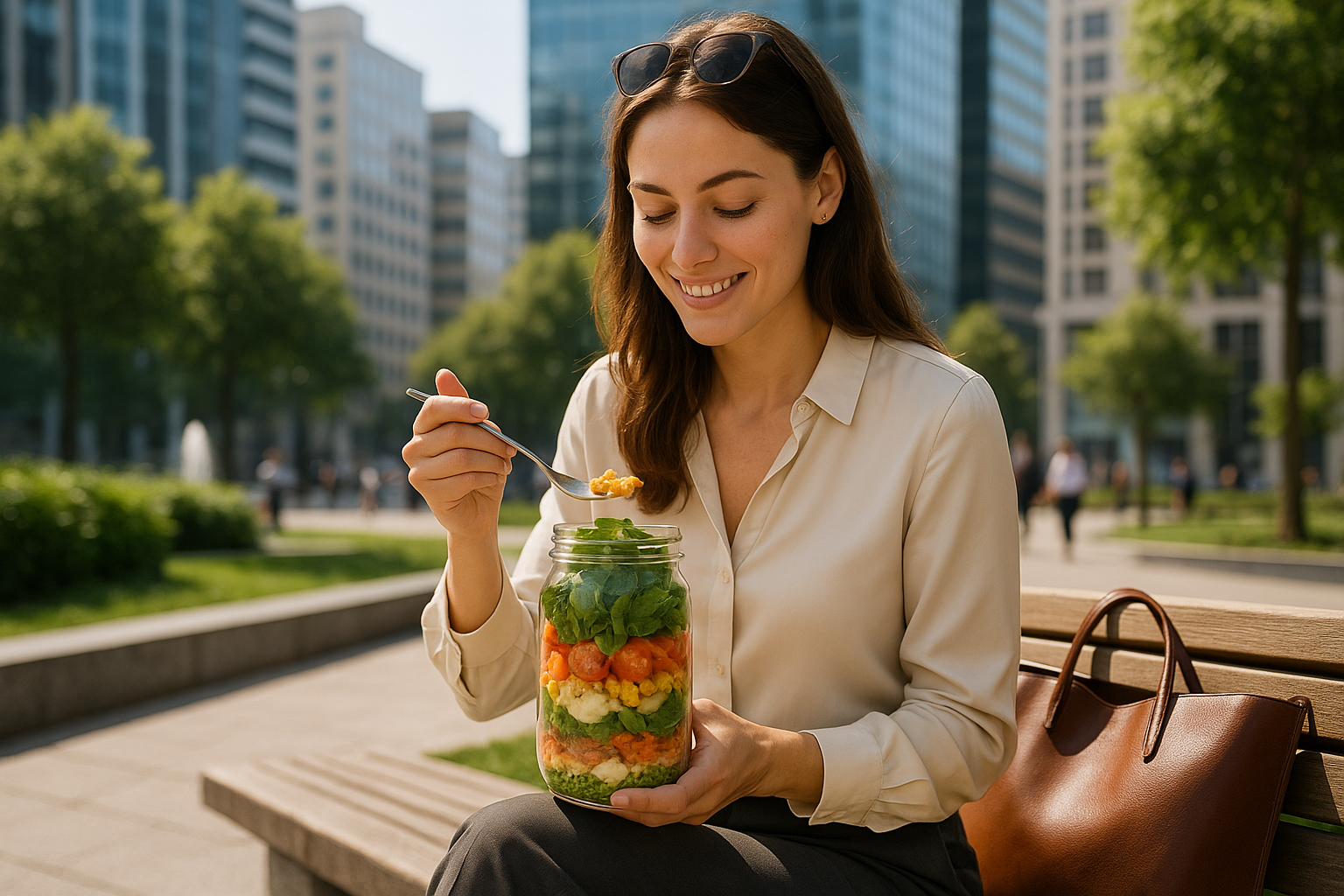However, amidst the hustle and bustle, one area that often gets overlooked is a healthy, balanced diet. The lure of grab-and-go options and meals that fit snugly into our schedule usually outweighs the thought of preparing a wholesome, nutritious lunch. This is where jar salads come into play, a game-changer for urban nomads looking to elevate their lunch game.
The concept of jar salads, or mobile meals, as they are sometimes referred to, is about much more than a simple trend. In reality, it is a response to a challenge that urban dwellers face daily – the need for easily transportable, nutritious meals that are also enjoyable to eat. These salads in a jar offer a practical solution to this issue, bringing together the best of both worlds: convenience and nutrition.
These jar salads are a great example of how you can make the most out of limited resources – time, space, and sometimes even ingredients. They’re easy to prepare, offer a wide variety of options, and can be tailored to suit anyone’s taste. The beauty of these salads lies in their versatility – from vegetarian to protein-packed options, there’s a jar salad for everyone. Plus, their portability makes them a perfect fit for the urban nomad lifestyle.
This article aims to shed light on the concept of jar salads, their benefits, and how they can help you maintain a balanced diet even on the busiest days. It will delve into the step-by-step process of preparing jar salads, share insights on selecting the right ingredients, and provide tips on how to store and transport them effectively. It will also highlight some creative and delicious jar salad recipes that can inspire you to start your own jar salad journey.
Even though jar salads might seem like a simple concept, understanding the science behind layering the ingredients and choosing the right combinations can significantly enhance the taste and nutritional value of your meal. To this end, this article will explain the importance of ingredient layering in jar salads and provide practical tips on how to get it right.
In the subsequent sections, we will explore how jar salads can contribute to reducing food waste, a pressing concern in urban societies. By planning your meals and using ingredients strategically, you can minimize waste and make a positive impact on the environment. The article will provide practical advice on how to use leftover ingredients in your jar salads, demonstrating that sustainability and good nutrition can indeed go hand in hand.
In addition to all this, the article will also delve into the cost-effectiveness of jar salads, a factor that is often overlooked. By preparing your own meals, you can save money and ensure that you’re consuming high-quality, nutritious ingredients. The article will offer insights on how to shop smart and make the most out of your budget when preparing jar salads.
While the concept of jar salads is straightforward, their impact extends far beyond a simple lunch solution. They embody a shift towards healthier, more sustainable eating habits that cater to the urban lifestyle. By the end of this article, you’ll have all the information you need to take your lunch game to the next level with jar salads, making them an integral part of your balanced, on-the-go lifestyle.
Introducing the Concept: Jar Salads
When it comes to creating a healthy, delicious, and portable lunch, jar salads are an absolute game-changer. These clever creations are the perfect solution for on-the-go urban nomads who are looking for a lunch option that is both nutritious and convenient.
Essentially, a jar salad is a salad that is layered in a jar, typically a mason jar. The concept is as simple as it sounds, but the execution can be an art form in itself. When assembled correctly, a jar salad can last for several days in the fridge, making them an ideal choice for meal prepping.
The key to a great jar salad is the layering. By placing the dressing at the bottom of the jar, and then layering the ingredients in a particular order, you can ensure that your salad stays fresh and crisp, rather than soggy and unappetizing.
Building Your Jar Salad: A Step-by-Step Guide
Creating a jar salad is an incredibly easy process. Here’s a step-by-step guide:
First, you start with the dressing. Pouring this in first ensures that your salad ingredients don’t get soggy. The next layer should be any hard vegetables or fruits, such as cucumbers, carrots, or apples. These create a barrier between the dressing and the rest of the ingredients.
After that, add your protein, such as grilled chicken, tofu, or hard-boiled eggs. Then add any softer vegetables or fruits, such as tomatoes or strawberries. Your final layer should be your leafy greens. By putting these at the top, you ensure that they stay dry and crisp.
Benefits of Jar Salads: Convenience and Nutrition on the Go
Jar salads offer a number of benefits, making them an ideal lunch choice for busy urban dwellers.
First and foremost, they are incredibly convenient. You can prepare a week’s worth of lunches in one go, and they’re easy to grab in the morning as you head out the door. They’re also portable and require no additional packaging, making them an environmentally friendly choice.
Additionally, jar salads allow you to control exactly what goes into your meal, so you can ensure that you’re eating a balanced, nutritious lunch. You can pack in plenty of fresh fruits and vegetables, lean proteins, and healthy fats.
Comparative Table: Jar Salad Vs Traditional Salad
| Jar Salad | Traditional Salad | |
|---|---|---|
| Convenience | High | Low |
| Portability | High | Low |
| Nutritional Control | High | Variable |
| Environmental Impact | Low | Variable |
As you can see from the table above, jar salads outperform traditional salads in several key areas. So why not give them a try? To get started, check out this video: “Healthy Mason Jar Salads for On-The-Go” on the channel “Tasty”.
Unlocking Unlimited Flavour Combinations with Jar Salads
The beauty of jar salads is that they are infinitely customizable. You can mix and match ingredients to suit your tastes and dietary needs. Love Greek flavors? Try a salad with feta, olives, cucumber, and a lemon vinaigrette. More of a Mexican food fan? Go for a salad with black beans, corn, avocado, and a cilantro lime dressing. The possibilities are endless.
Moreover, switching up your ingredients regularly can help prevent “salad fatigue”. By keeping things interesting and varied, you’re more likely to stick with your healthy eating goals.
Ready to elevate your lunch game with jar salads? Start experimenting with different combinations and discover your own signature salad. Happy meal prepping!

Conclusion
In concluding this in-depth analysis, it is imperative to reiterate the key points that have been extensively covered throughout this article. We commenced with an elaborate discussion on the fundamental tenets of software engineering and its overarching influence in today’s technology-driven world. We also delved into the distinctive spheres of IT, emphasizing the significant role they play in shaping our digital realm.
A software engineer’s contribution to any organization is unparalleled, translating complex ideas into codes that, when executed, bring about revolutionary change. An in-depth understanding of programming languages, algorithms, data structures, and more are crucial in this regard. We thoroughly examined these elements, elucidating the intricate details that make them essential to the field of software engineering.
Moreover, we explored the realm of IT, underscoring the various domains that come under its umbrella. Be it network management, systems administration, or cybersecurity, each area of IT holds immense potential and value in today’s digital world.
One of the pivotal sections of our discussion was dedicated to the synergistic relationship between software engineering and IT. We examined how these two domains, though distinct, work hand in hand to build, maintain, and enhance the digital solutions of today. The interplay between them is a fascinating area of study and has tremendous implications for the future of technology.
Furthermore, this article touched on the importance of continuous learning and staying updated in these fast-paced fields. The dynamic nature of technology requires professionals to stay ahead of the curve, constantly updating their knowledge base and skills.
It is evident from our discourse that software engineering and IT are not just fields of study but are the very foundation of the digital revolution we are witnessing. Their importance cannot be overstated, and their influence is set to continue growing exponentially in the coming years.
In conclusion, our exploration into the realms of software engineering and IT paints a vivid picture of their complexity, interdependencies, and immense significance. It underscores the importance of understanding and leveraging these domains to stay competitive and make meaningful contributions to the digital world.
As always, your feedback and thoughts are highly appreciated. Feel free to share your insights, questions, or experiences in the comments section below. If you found this article informative, do not hesitate to share it with others who might benefit from it.
Finally, for those who wish to delve deeper into these subjects, here are a few references that can further enrich your understanding:
1. [Software Engineering: A Practitioner’s Approach](https://www.mheducation.com/highered/product/software-engineering-practitioner-s-approach-pressman-maxim/M9780078022128.html)
2. [Computer Networking: A Top-Down Approach](https://www.pearson.com/us/higher-education/product/Kurose-Computer-Networking-A-Top-Down-Approach-7th-Edition/9780133594140.html)
3. [Introduction to the Theory of Computation](https://www.cengage.com/c/introduction-to-the-theory-of-computation-3e-sipser/9781133187790PF/)
Remember, the journey of learning never ends, and every step taken in pursuit of knowledge brings us closer to our goals. Let’s continue to learn, grow, and make a difference in the world of technology.
Published by Rodrigo Almeida.



